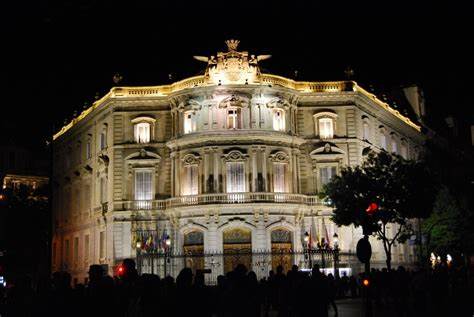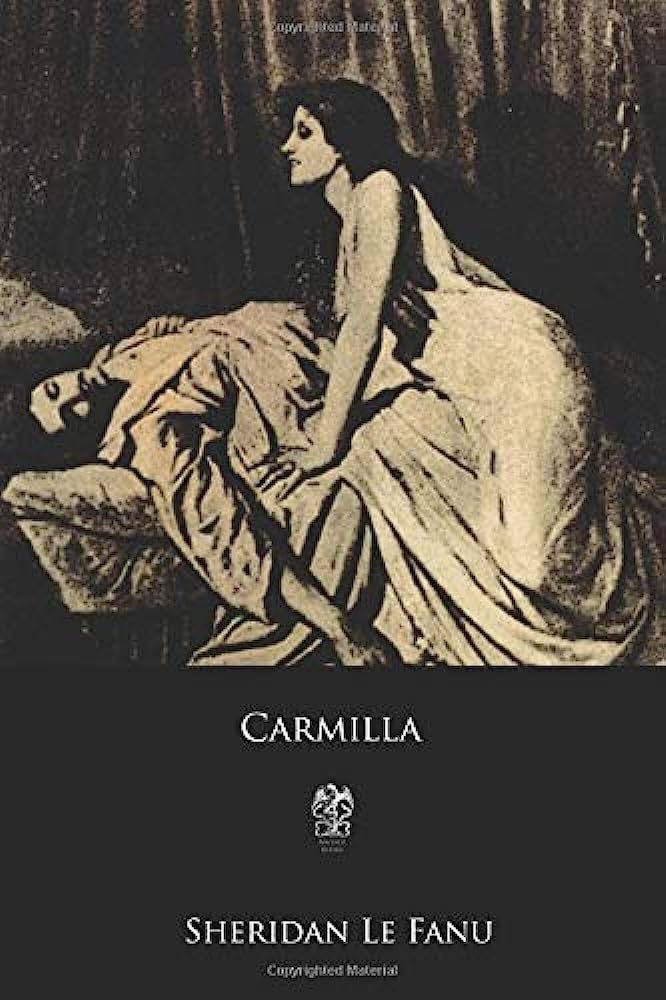If you are using Chrome, click the red hand button at the top right of the screen:

Then select: Don't run on pages on this site
If you do it correctly, the red hand will turn to green and you will no longer see this message.
Emilia Pardo Bazan (1851-1921) is one of the few nineteenth-century women writers accepted by the Spanish literary establishment as canonical and the most prominent of those few. Although she lived in Madrid for much of her adult life and also travelled widely, she was a Galician and set many of her fictional texts there, including “Vampire”, that is not a really story about sanguine vampires but about energetic vampires (or vampyres that we use to say now)
Synopsis
Don Fortunato Gayoso, an old man of seventy-seven years, marries the young Inés of fifteen, niece of the priest of Gondelle. Although at first it seems like a very advantageous marriage for Inés, due to her husband's wealth and his apparent fragility, which will soon allow her to receive a copious inheritance, in exchange for assisting the old man in the last moments of his life, not everything is as it should be. what it seems.
Behind this marriage of convenience is Don Fortunato's intention to regain health, following the advice of specialists, through Inés' youth. In this way the old man begins to improve and rejuvenate, while Inés slowly wastes away until she dies before turning twenty.
After the success of his "treatment", Don Fortunato looks for a new girlfriend, although he will have to do so outside the town to avoid alarming the neighbors.

A gothic roman?
However, despite the vampire theme, my opinion is that this novel cannot be considered "gothic". It is certainly a novel of manners and traditions, set in the era of romanticism in a region of Spain, Galicia, which, being located next to the Atlantic Ocean, has a climate and landscape similar to so many English regions.
Although the story has many typical Gothic ingredients (the mansion, the bucolic atmosphere, surprises in the characters' lineage, etc.), in my opinion something essential is missing: the feeling of uncanny. In fact, it is more of a psychological and tradicionalist novel than a horror roman.
All in all, since it is a short story, it is worth reading, and I recommend it, as it does not fail to provide its dose of culture to lovers of Gothicism
Today is September 1st, the children go back to school and, of course, the vampires come back to my Gothic Literature Little School.
And we restart the course with a reading proposal that, surely, many of you already know: Carmilla, the famous novel about a vampire -who is not a vampire- written by Sheridan Le Fanu in 1872.

I think it's a mistake that many publishers, articles and websites classify it as a lesbian novel. I'm sorry but, despite whoever it may be, gender language was not invented in the 19th century, nor was it necessary. In 1872 a woman could say to another "I love you" or even kiss her in public, without this implying a sexual insinuation (in the same way that seeing two Turkish men walking hand in hand does not suggest a homosexual relationship between them). Let us not try to reformulate history with the concepts - or misconceptions - that emerged from the sexual revolution of the 60s of the 20th century because, among other things, we would destroy the richness of the culture of Romanticism in general, and Gothicism in particular.
No, Carmilla is not a lesbian novel. The same as Dracula is not an exaltation of the phallic power that is nailed to its victims. But what can we do! People want to sell books at any price, even suggesting the most bizarre psycho-interpretations.
But let's go in parts. Let us first analyze whether or not this novel can be classified as Gothic. In my opinion, there would not be the slightest doubt based on the criteria of "gothicity" proposed by the literature specialized in use (we cite, for example, David Stevens, "The Gothic Tradition" or César Fuentes Rodríguez, "Mundo Gótico") and that in this blog, we follow:
The plot takes place in a castle, described as a gothic, medieval, ancestral environment... In fact, not just in one, but in several: Laura, the protagonist, lives with her father in an isolated castle located in Austria, in the Styria region. But also, at the height of history, the ruins of another castle appear, in whose cemetery the Countess of Karnstein is buried.
A series of family plots follow one another. There is a double relationship between Laura and her father -widower-, but also between the General -a great family friend and also a widower- with his daughter. Both parents, devoted to the happiness of their daughters. It contrasts, however, with the relationship, in the case of Carmilla, of mother-daughter, a mother who, despite affirming that her daughter is delicate, does not hesitate to abandon her in the Castle of Laura's father, when his carriage has an accident. but the mother, in a hurry for some unknown reason, abandons her. Something also parallel to what happened to the General. The fact of the dark carriage, where her tutor (mother or aunt) very similar to Dorottya Szentes and Darvulia, or that Mircalla was the last of her cursed dynasty, draws attention at night to seduce her victims.
A background marked by a prophecy or ancestral signs is present... Karnstein castle, in ruins, is located in a mysteriously abandoned village, why did the population leave? And, curiously, the denouement of the novel takes place in the cemetery, after a search for the place where Countess Karnstein should be buried...
A series of events that are difficult to explain occur: when Carmilla, still sleeping with the door closed, sees her friend in the bedroom, how is this possible? The same, in parallel, would have happened in the story that the General tells related to the party he attends with his daughter...
True to the atmosphere of 21st century Romanticism, we find ourselves with emotions pushed to the limit; the ladies have those marvelous "Gothic diseases" which, when unwell, oblige them to remain in bed. It is even seen with total normality that Carmilla remains in bed, or secluded in her rooms, until mid-afternoon and that when she goes down, already to have dinner, the sun has set. It's normal, let's see, why would I get up early if I didn't have to be at 8 in the morning in an office working?
But, above all, there is that feeling of "uncanny" throughout the novel; The reader, no matter how sensitive he may be, shudders when he describes the rooms of the castle, the walks along the drawbridge, which no longer lifts, or, alas! those little incisions in the neck that shouldn't be there, because we left the door closed.
Not only does this novel seem Gothic to us, but we dare say that it is as pure Gothic as that of "The Castle of Otranto."
Let's talk a little about the author. Joseph Thomas Sheridan Le Fanu (1814 – 1873) was an Irish writer of short stories and mystery novels. His ghost stories represent one of the earliest examples of the horror genre in its modern form, in which, as in his tale Schalken the Painter, virtue does not always triumph or a simple explanation of supernatural phenomena is offered. We like it for that.
He studied Law at Trinity College Dublin, where he was appointed auditor of the Historical Society. But Le Fanu did not like the laws (normal, on the other hand) and went into journalism. From that moment until his death he published many stories. From 1861 to 1869, he edited the Dublin University Magazine, which published many of his works in installments (now known in Gothic circles as "penny dreadfuls" because they were "penny" installments, and which would give its name to the famous TV series).
Le Fanu's intrigues, of great intensity, are perfectly constructed. His specialty consisted in the recreation of "atmospheres" and "effects" rather than mere fright - do you now understand the "uncunny" I mentioned earlier? - often within a mystery format. Reading novels like Carmilla about a vampire woman, with a very effective plot, powerfully influenced Bram Stoker for his Dracula.
One of his early works, An Episode in the History of the Tyrone Family (1839), may in turn have been inspired by Emily Brontë's Wuthering Heights. It has sometimes been claimed that Le Fanu is the father of the Victorian Irish ghost story. Judging by the significance of his work, it is surprising that his contribution has not been better considered.
His best-known stories, still widely read today, are the macabre mystery novel Uncle Silas (1864), The Rose and the Key (1871), and the highly celebrated collection In a Mysterious Glass (1872), which contains Carmilla, as well as Green Tea and The Acquaintance, two famous accounts of enigmatic events apparently summoned by a dark guilt.
Other fictions by Le Fanu are The Purcell Papers, divided into three volumes; The house next to the cemetery (1863); Wylder's Hand (1864); Guy Deverell (1865); Enchanted Lives (1868); The Wyvern Mystery (1869), and the posthumous publication The Watcher and Other Macabre Stories (1894), another collection of short stories.
COMMENTS
I think in many ways the hammer horror films about Mircalla always tried to push the whole lesbian countess agenda . Even though a couple of times she was indulging two men in a grand love affair . The karnsteins were always shown as a family of satanists who practiced every evil known to man . Vampirism was just a small part of a long line of evil . The novels are often a better place to start for understanding a character and their intentions
COMMENTS
-
John666
17:23 Sep 16 2023
Sounds like a great short story.